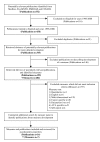Measuring the psychosocial health of adolescent and young adult (AYA) cancer survivors: a critical review
- PMID: 20205922
- PMCID: PMC2850329
- DOI: 10.1186/1477-7525-8-25
Measuring the psychosocial health of adolescent and young adult (AYA) cancer survivors: a critical review
Abstract
Background: Adolescent and young adult (AYA) cancer survivors require psychometrically rigorous measures to assess their psychosocial well-being. Without methodologically adequate scales the accuracy of information obtained on the prevalence of needs, predictors of risk, and the potential success of any interventions, can be questioned. This review assessed the psychometric properties of measures designed specifically to identify the psychosocial health of this unique population.
Methods: Medline, PsycINFO, CINAHL and EMBASE databases were searched to identify measures developed to assess the psychosocial health of AYA cancer survivors. Searches were limited to the years 1998-2008. A search of Medline revealed that the number of publications related to the assessment of psychosocial well-being in AYA cancer survivors prior to this period were minimal. The psychometric properties of identified measures were evaluated against pre-determined and generally accepted psychometric criteria including: reliability (internal consistency and test-retest); validity (face, content, construct, and criterion); responsiveness; acceptability; and feasibility.
Results: Seven quality of life measures met the inclusion criteria. No measures of unmet need were identified. All seven measures reported adequate internal consistency, face, content, and construct validity. Test-retest reliability, criterion (predictive) validity, responsiveness, acceptability, and feasibility were rarely examined.
Conclusions: There is a need to further evaluate the psychometric properties of existing quality of life measures for AYA cancer survivors. Valid, reliable, and acceptable measures which can assess the psychosocial needs of this population should also be developed.
Figures


Similar articles
-
Measuring quality of life in cancer survivors: a methodological review of existing scales.Psychooncology. 2008 Jul;17(7):629-40. doi: 10.1002/pon.1281. Psychooncology. 2008. PMID: 17973235 Review.
-
Assessing unmet supportive care needs in partners of cancer survivors: the development and evaluation of the Cancer Survivors' Partners Unmet Needs measure (CaSPUN).Psychooncology. 2007 Sep;16(9):805-13. doi: 10.1002/pon.1138. Psychooncology. 2007. PMID: 17177180
-
Development of a social inclusion index to capture subjective and objective life domains (Phase II): psychometric development study.Health Technol Assess. 2012;16(1):iii-vii, ix-xii, -1-241. doi: 10.3310/hta16010. Health Technol Assess. 2012. PMID: 22260923 Clinical Trial.
-
The cancer support person's unmet needs survey: psychometric properties.Cancer. 2009 Jul 15;115(14):3351-9. doi: 10.1002/cncr.24386. Cancer. 2009. PMID: 19472397
-
Assessing the needs of informal caregivers to cancer survivors: a review of the instruments.Psychooncology. 2015 Feb;24(2):121-9. doi: 10.1002/pon.3609. Epub 2014 Jun 14. Psychooncology. 2015. PMID: 24930811 Review.
Cited by
-
The feasibility of psychosocial screening for adolescent and young adult brain tumor survivors: the value of self-report.J Cancer Surviv. 2012 Dec;6(4):379-87. doi: 10.1007/s11764-012-0237-7. Epub 2012 Aug 18. J Cancer Surviv. 2012. PMID: 22903638
-
Health-Related Quality of Life of Young Adult Survivors of Childhood Cancer: A Review of Qualitative Studies.J Adolesc Young Adult Oncol. 2011 Sep;1(3):124-132. doi: 10.1089/jayao.2011.0033. J Adolesc Young Adult Oncol. 2011. PMID: 23610733 Free PMC article.
-
Harmonizing evidence-based practice, implementation context, and implementation strategies with user-centered design: a case example in young adult cancer care.Implement Sci Commun. 2021 Apr 26;2(1):45. doi: 10.1186/s43058-021-00147-4. Implement Sci Commun. 2021. PMID: 33902748 Free PMC article.
-
Evaluating a novel hospital-based online health community to address palliative and psychosocial care factors for chronically ill adolescent and young adult patients.Palliat Support Care. 2024 Jun;22(3):432-443. doi: 10.1017/S1478951523000147. Palliat Support Care. 2024. PMID: 36847132 Free PMC article.
-
Screening young adult cancer survivors for distress with the Distress Thermometer: Comparisons with a structured clinical diagnostic interview.Cancer. 2016 Jan 15;122(2):296-303. doi: 10.1002/cncr.29736. Epub 2015 Oct 12. Cancer. 2016. PMID: 26457669 Free PMC article.
References
-
- Mathers C, Lopez A, Murray C. In: Global Burden of Disease and Risk Factors. Lopez A, Mathers C, Ezzati M, Jamison D, Murray C, editor. New York: Oxford University Press; 2006. The Burden of Disease and Mortality by Condition: Data, Methods and Results for 2001; pp. 45–93. 174. - PubMed
-
- Soliman H, Agresta SV. Current issues in adolescent and young adult cancer survivorship. Cancer Control. 2008;15(1):55–62. - PubMed
-
- Pollock BH, Birch JM. Registration and classification of adolescent and young adult cancer cases. Pediatric Blood & Cancer. 2008;50(5 Suppl):1090–1093. - PubMed
Publication types
MeSH terms
LinkOut - more resources
Full Text Sources
Medical
Miscellaneous

